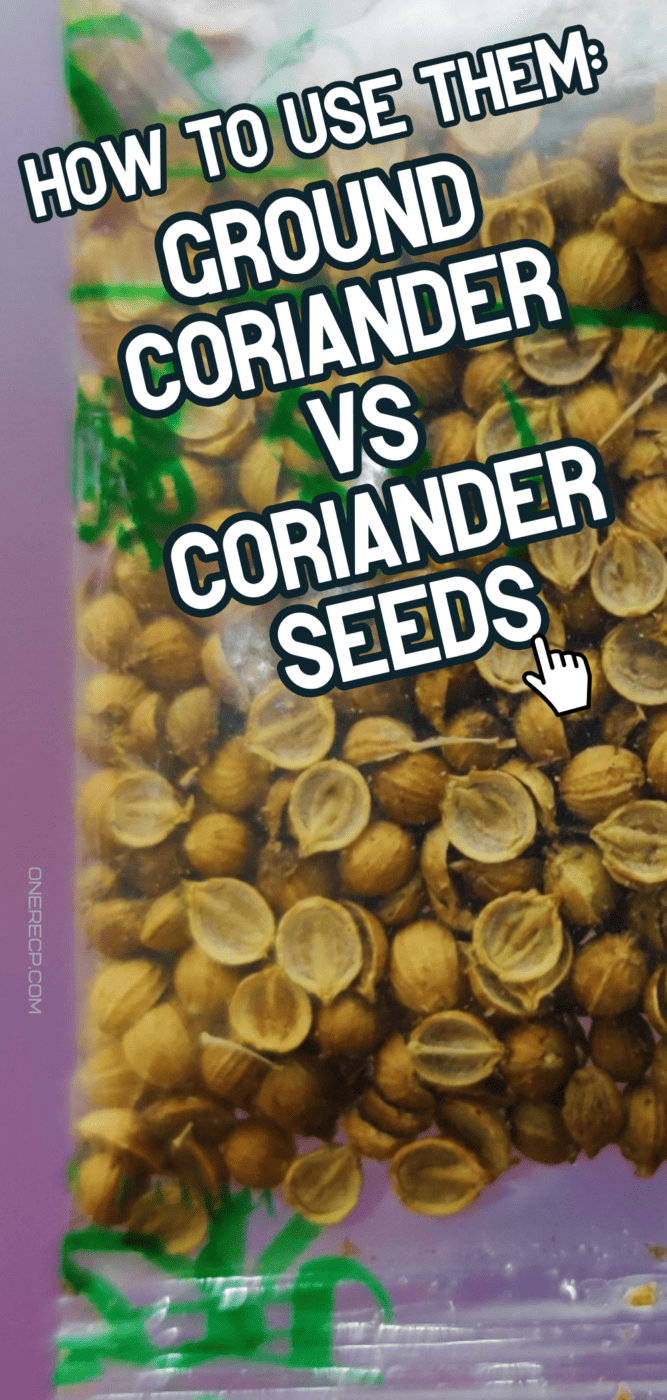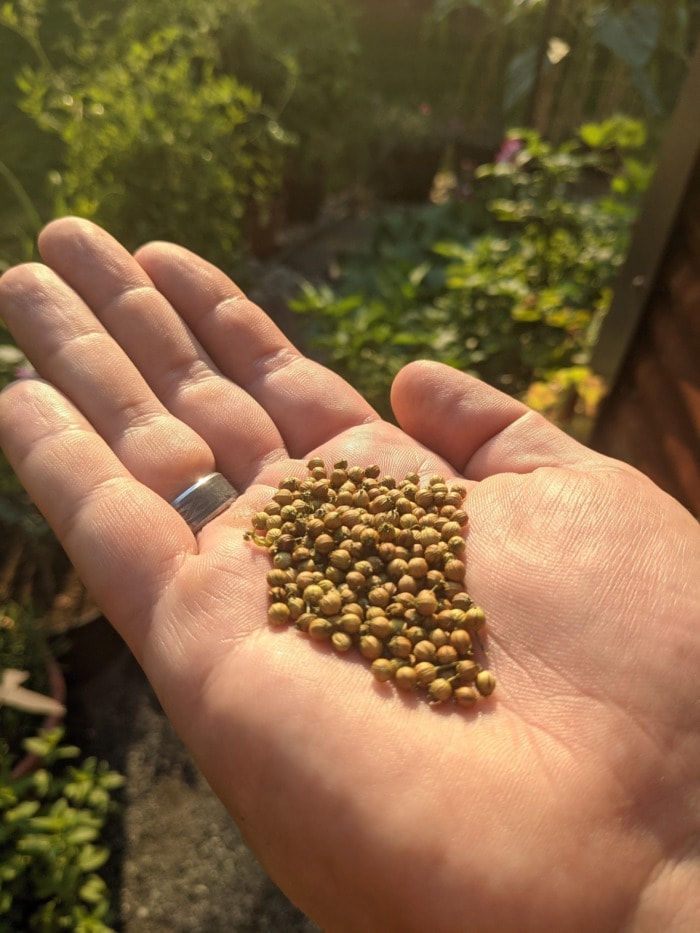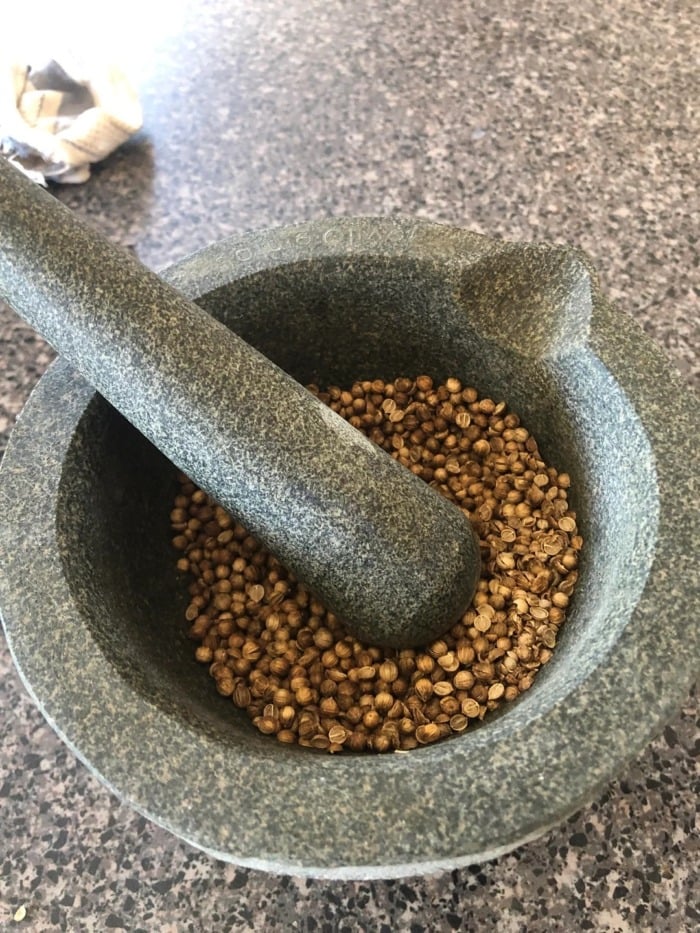Coriander is a spice that’s widely used in Mediterranean, Chinese and Mexican cuisine.
It comes in the form of a ground powder or seeds which can occasionally be substituted for each other.
However, each of these forms has its own unique properties so they’re mostly used for specific cooking applications.
In this article, I’ll take a look at what sets ground coriander and coriander seeds apart so you can know when to substitute them.

Which one to use – ground coriander versus coriander seeds?
Both ground coriander and whole coriander come from the seeds of the Coriandrum sativum also known as cilantro.
Even though ground coriander and coriander seeds are harvested from cilantro, they’re not interchangeable.
The term cilantro refers to the leaves of the plant which have a vastly different aroma than the seeds.
Having said that, ground coriander and coriander seeds also have some differences between each other.
Like most whole spices, coriander seeds have a tough texture and are mostly used in brines, marinades and stews. Ground coriander on the other hand, has a fine texture and dissolves in hot liquids. This is why it’s mostly used in sauces, soups and stir fries.
As a result of these differences, each form is typically added at different times in the cooking process.
Since whole coriander seeds retain their texture they’re usually added at the beginning of cooking, while ground coriander is added midway or at the end of cooking.
In terms of flavor, whole coriander seeds have a strong earthy flavor with a delicate citrusy aroma.
Ground coriander also shares these qualities, but its aroma is more mellow than that of the seeds.
It’s also worth pointing out that coriander seeds are more potent and can maintain their flavor for longer.
When they’re stored in an airtight jar in a cool dry environment, coriander seeds can stay fresh for up to a year.
In comparison, the aroma of ground coriander can decrease in quality in just a few months.
So if you want to get the most flavor from coriander it’s better to make your own ground coriander from seeds.
How to make ground coriander from seeds?
Making ground coriander from coriander seeds is extremely easy. All you need to do is roast the seeds and grind them with a coffee grinder.
You can simplify this process even further by grinding the seeds without roasting them.
However, the powder will have a slightly rougher texture since the seeds won’t be as brittle as when they’re roasted.
Anyways, here’s how to make ground coriander from coriander seeds:
Step 1 – Roast the coriander seeds.
Start by heating a heavy bottom pan or a wok on medium heat for 3 minutes.
Once the pan is heated, stir in the coriander seeds and dry roast them for roughly 5 minutes.
The seeds will be ready when they turn slightly dark and release their aroma.
After you finish roasting the seeds, turn off the heat and transfer them onto a plate.
This will stop the cooking process and allow the seeds to cool off.
Let the seeds rest for 30 minutes or until they’ve completely cooled down.

by TheBrotherEarth
Step 2 – Grind the seeds.
Transfer the coriander seeds into a coffee or spice blender and blend them in batches.
Blend the seeds a few times by shaking the grinder to prevent them from sticking to the sides.
You can use a spoon to scrape some of the powder in between batches.
Keep grinding the seeds until they reach a fine texture.
If you don’t have a coffee or spice blender you can also grind the seeds by using a mortar and pestle.
Once the seeds turn into a fine powder you can store them in an airtight jar for two to six months.

by I_am_Green_Dragon
Can you use ground coriander instead of coriander seeds?
If a recipe calls for coriander seeds but you don’t have any at hand, you might start debating if you can use ground coriander instead.
Fortunately, ground coriander can be used as a substitute for coriander seeds in marinades, stews or spice blends.
However, you should avoid using it in brines as it will dissolve and make them cloudy.
If you decide to substitute coriander seeds for ground coriander you should keep in mind that the rate isn’t 1:1.
Coriander seeds have more volume so you’ll need to use less ground coriander.
In essence, 1 tablespoon of coriander seeds equals 3/4 tablespoons ground coriander.
Conversely, if you’re using coriander seeds instead of ground coriander you’ll need to use 1/4 tablespoons more.
Don’t forget that coriander seeds are stronger than ground coriander, so your final dish won’t taste exactly as it was intended.
If a recipe is made with coriander seeds in mind it’s always best to stick to it for optimal results.
My short recap
Even though ground coriander and coriander seeds taste nearly identical they do have some subtle differences.
Coriander seeds are usually more pungent and can retain their texture which makes them best suited for brines, marinades and stews.
Ground coriander on the other hand has a finer texture and a mellower taste so it’s better for soups, sauces and stir fries.
In any case, both forms can be used interchangeably for most dishes with the exception of brines.
When you’re making a brine it’s best to stick to coriander seeds.
Anyways, I’d love to hear from you down in the comments.